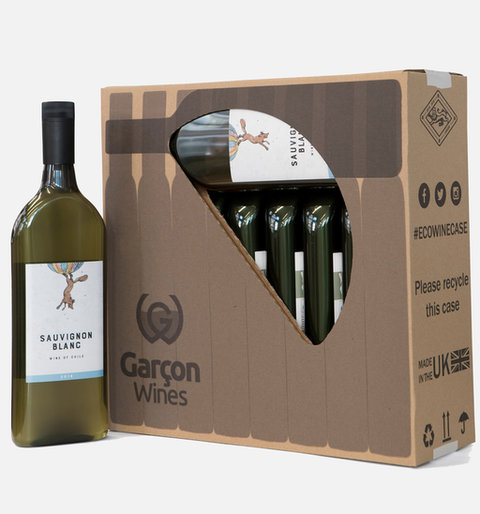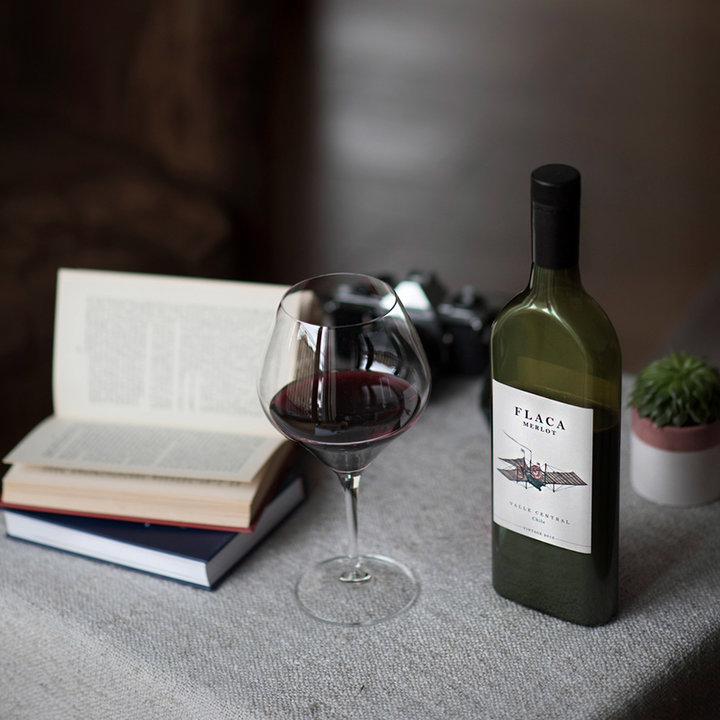plastic | design
plastic | design
A new vintage: re-thinking the wine bottle
Compared to other drinks packaging, the wine bottle has arguably seen little evolution over the years. However, one company is looking to change that with a new design for a new age. Peter Nilson speaks to Garçon Wines CEO Santiago Navarro to find out more.
All images: Garçon Wines
It may not be obvious,
but from a logistic perspective wine bottles are, frankly, incredibly inefficient. Considering the fact that most wine bottles are made of glass, one realises that they are unnecessarily heavy.
The cylindrical shape is similarly non-optimal, with lots of negative space in a case of wine. In turn, these two factors lead to higher costs and an unnecessary environmental impact when transporting the drink.
Garçon Wines is trying to solve this problem by producing slim-form, recycled plastic wine bottles. The packaging is also designed to fit through a letterbox - which might initially come from the early concept of wine delivery directly to the consumers door, but also leads to more efficiency when shipping.
These bottles are lighter and can be stacked in cases more efficiently when shipped, all leading to lower shipping costs and a reduced environmental impact.
A new bottle for a new age
It’s been a successful journey so far for Garçon Wines. Helmed by CEO and co-founder Santiago Navarro, the company initially launched in 2017 with a plan to enter the D2C market, however those plans had to change rapidly after the initial prototype announcement - certainly a problem, albeit a nice one to have.
“There was such interest in what we were doing, we decided to go back to the drawing board,” explains Navarro. “Should we be a company that executed our invention and our intellectual property alone in the UK? Or should we do some more R&D and offer it at a greater scale?”
They chose the latter decision, and it took over a year for a completely new business plan to be developed. During that time the company also shifted to using recycled plastic to create the bottles, working with RPC M&H Plastics, who has since been bought by Berry Global, to produce the bottles in the UK.
“I realised that the potential implications of producing a product at such volumes meant that we needed to produce a bottle entirely from recycled plastic,” adds Navarro.

The bottle's slim form factor allows for efficient packaging.
Indeed, it’s apparent that Navarro is fully aware of the impact of the materials used. “I do believe there's an opportunity to replace a 19th century wine bottle with a 21st century wine bottle,” he says.
But what is that 21st century wine bottle? “At the moment recycled plastic is the right answer,” says Navarro. “Maybe in 10 years time it's not, and we will remain open to reconsider [other] polymers or materials - we are not in any way wedded to a specific material.”
That sentiment is apparent in the company’s continued R&D efforts - it’s clearly an area that Garçon Wines is both consciously and constantly focusing on. “We will always do what's right, rather than what's easy or cheap,” adds Navarro.
We will always do what's right, rather than what's easy or cheap
A flexible business approach
By May 2018, almost two years on from the initial launch of the product, Garçon Wines was shipping these recycled plastic bottles to partners. The strategy seems two-fold for the company, which is primarily at this point acting as a wine wholesaler.
Having worked with the likes of Naked Wines, Mondelez and Moonpig, there is a clear interest in the product, and an opportunity for Garçon Wines to offer a full turnkey solution. “We will continue to do elements of that, because there are many companies across the wine value chain that require a turnkey solution.”
However, the company does also work with wine producers to provide packaging, having recently announced a partnership with Accolade Wines, which will see a number of new world varieties packaged in the slim form packaging - including the UK’s number one wine brand, Hardys.

The draw for these companies is easy to see: with a lower weight, the shipping costs also reduce, as well as the environmental impact. As Navarro rightly points out, the 87% reduction in weight per bottle, from a 500g average bottle weight to 62g, cuts 500g of CO2 per bottle from the supply chain.
That alone, replicated across millions of bottles, has a “massive potential positive impact, both in terms of reducing the environmental costs but also the financial costs”.
Looking Forward: where next for Garcon Wines?
So what does the future hold for the company? Recent partnerships hint at a more global effort, with an agreement in place with Amcor helping Garçon Wines position itself in the US market.
Similarly, Navarro hints at potential opportunity in the Nordics, where, barring Denmark, the sale of alcohol is heavily controlled by state-run monopolies. “Every year they release an annual report, and most of them, on the executive summary page, asked for low carbon footprint 75cl bottles, and they've asked for that for ages.”
It’s clear that Navarro sees Garçon Wines as uniquely positioned to help with this demand. Indeed, the company has looked into opening an office in Sweden in order to capitalise on this potential.
Outlining the future of the company, Navarro confirms the focus is to be “multi-channel and multi-country”. With an increased presence in the US, Garçon Wines is also looking at potential markets in Australia and New Zealand.
And, considering the inherent benefits in weight reduction, it’s clear that the potential in the aviation sector is huge. Though nothing is yet official, Garçon Wines is in talks with major airlines to offer a turnkey solution.
“Airlines increasingly recognise the need to first of all to reduce the carbon footprint, but secondly, to reduce the amount of single use plastic - by using 100% post consumer recycled bottles.” adds Navarro.
The future certainly does look promising; and as more big names come on board, slim-form plastic bottles may well become more prevalent across the wine industry.
“It’s absolutely clear,” says Navarro, “that we can make a change. Rest assured if I can do it, anyone can do it.”
The bottle's slim form factor allows for efficient packaging. All images: Garçon Wines